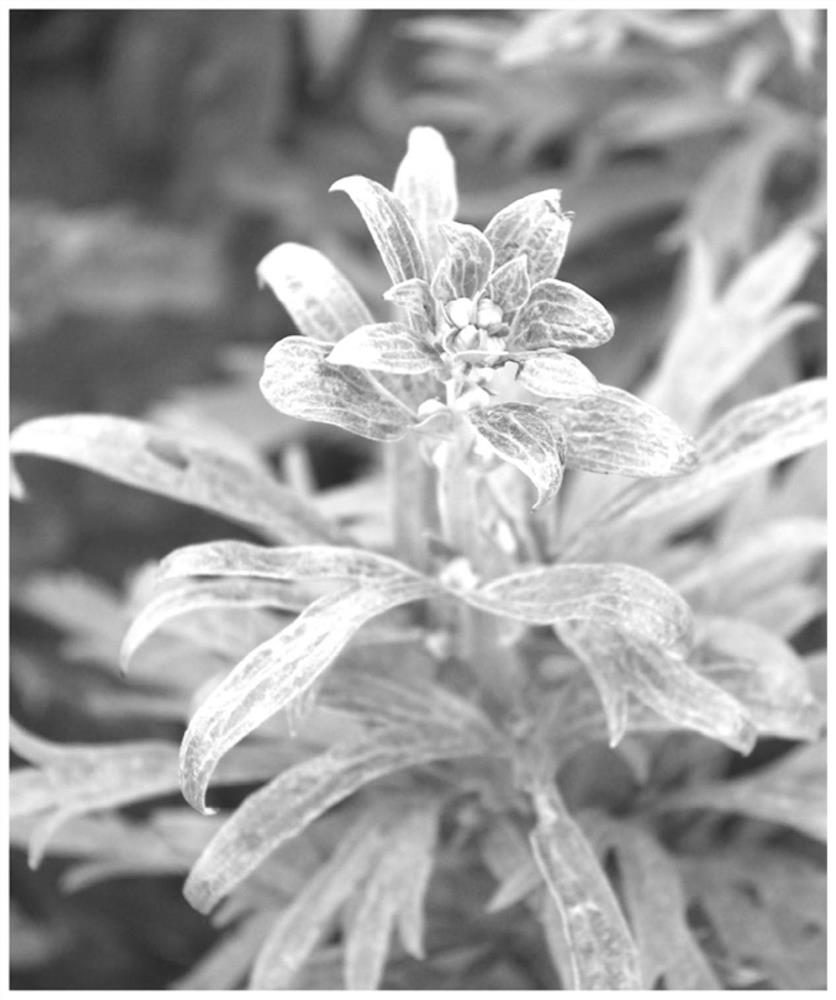RT-PCR detection primer and method for aconitum A virus
A technology of aconitum and virus, which is applied in the field of plant disease diagnosis and can solve the problem that the type of linear virus of aconitum mosaic disease is not determined.
- Summary
- Abstract
- Description
- Claims
- Application Information
AI Technical Summary
Problems solved by technology
Method used
Image
Examples
Embodiment 1
[0098] Example 1. Identification and sequencing of pathogens
[0099] In September 2018, the inventor found Aconitum carmichaelii Debx. ( figure 1 ).
[0100] Total RNA was extracted from symptomatic leaves using TRNzol reagent (Tiangen, Beijing, China). Small RNA libraries were constructed using the TruSeq Small RNA Library Preparation Kit (Illumina, San Diego, USA), and paired-end (paired) sequencing was performed on the Illumina HiSeq2500 platform.
[0101] After sequencing, a total of 34,673,599 reads were obtained. After removing low-quality reads, contigs were assembled using the Velvet de novo algorithm. A total of 167 contigs ranging from 50bp to 853bp were obtained, and the contigs were annotated using the localized BLASTn program with reference to the GenBank virus database.
[0102] The results showed that 63 contigs from 50bp to 181bp had high sequence identity (68% to 94%) with multiple Carnation latent virus genus viruses; Viruses of the genus have high sequ...
Embodiment 2
[0114] Example 2. Establishment of Aconitum A virus (AcVA) detection method
[0115] 1. Design of primers:
[0116] According to the complete genome sequence of AcVA virus, use the Primer Premier 6 software to design the detection primers of AcVA, the primer design site includes the nucleotide sequence of AcVA encoding replicase, three-gene box, coat protein and cysteine-rich protein (i.e. Any fragment at any position in ORF1 to ORF6).
[0117] Primer design principles are:
[0118] 1) The primer specifically binds to any fragment of the AcVA genome;
[0119] 2) The primer length is 15bp to 30bp;
[0120] 3) G+C content between 40% and 60%;
[0121] 4) There can be no consecutive 4 base complementarity within and between primers;
[0122] 5) The Tm value of the primer is 55±5°C;
[0123] 6) The length of the amplified product is 300bp to 3000bp.
[0124] Exemplary detection primers designed according to the above design principles, such as:
[0125] Table 2. Exemplary ...
Embodiment 3
[0134] Example 3. RT-PCR Detection of Aconitum Sample AcVA
[0135] In order to verify that the pair of detection primers can detect AcVA virus in different samples:
[0136] 1. In the Aconitum planting area of Boye County, Hebei Province, 12 Aconitum leaf samples showing mosaic symptoms were collected.
[0137] 2. Weigh 0.1g of each sample and grind it fully in liquid nitrogen. Use TRNzol reagent (Tiangen, Beijing) to extract the total RNA of the leaves. The specific steps refer to the instructions. The extracted total RNA is dissolved in 30 μL DEPC ddH 2 O, store at -80°C for later use.
[0138] 3. Use Nanodrop2000 to measure the concentration of total RNA, use 500 to 2000ng total RNA as a template, use random hexamer primers and Oligo d(T) 18 As a primer, reverse transcription was performed using M-MLV reverse transcriptase (Promega, USA) to synthesize the first strand of cDNA. The reaction system refers to the instruction of M-MLV reverse transcriptase: total RNA 500 ...
PUM
 Login to View More
Login to View More Abstract
Description
Claims
Application Information
 Login to View More
Login to View More - R&D
- Intellectual Property
- Life Sciences
- Materials
- Tech Scout
- Unparalleled Data Quality
- Higher Quality Content
- 60% Fewer Hallucinations
Browse by: Latest US Patents, China's latest patents, Technical Efficacy Thesaurus, Application Domain, Technology Topic, Popular Technical Reports.
© 2025 PatSnap. All rights reserved.Legal|Privacy policy|Modern Slavery Act Transparency Statement|Sitemap|About US| Contact US: help@patsnap.com



